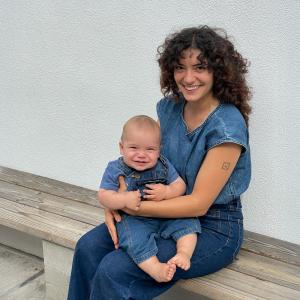
Margarita Martinez with her 11-year-old daughter, Fernanda, who had robotic surgery for a life-threatening tracheal tumor.
Photo: NYU Langone Staff
It was supposed to be an exciting trip to the Big Apple, but 11-year-old Fernanda Martinez, from Mexico City, could not stop coughing. Her mother, Margarita, found an urgent care close to their hotel. She expected a course of antibiotics; instead, she got a trip to the KiDS Emergency Department at the Ronald O. Perelman Center for Emergency Services.
The amount of oxygen in Fernanda’s blood was dangerously low. She felt chills and then began vomiting. When a COVID-19 test came back positive, she was given steroids to boost her lung capacity, as well as other medications, but her oxygen levels never bounced back. As Fernanda’s condition declined, she was moved to the Pediatric Intensive Care Unit at Hassenfeld Children’s Hospital at NYU Langone, where a new symptom developed: pneumothorax, or collapsed lung.
“Air was trapped between the lungs and the chest wall,” explains pediatric pulmonologist Eleanor Muise, MD. “You could feel it under her skin and in her neck. Air was in all kinds of places where it did not belong.”
One thing became clear: Something more than COVID-19 was at play, and a CT scan of Fernanda’s chest confirmed it. “We saw a mass that nearly completely blocked the main airway, or trachea, along the path that air takes getting into the lungs,” says Dr. Muise.
For Fernanda, catching COVID-19 turned out to be a lifesaver—a kind of fortunate misfortune. Without it, her doctors never would have discovered the giant mass blocking air flow to her lungs. But the ordeal wasn’t over yet.
To get a full view of the growth, Jamie L. Bessich, MD, an interventional pulmonologist, performed a highly specialized rigid bronchoscopy, placing a long metal scope into Fernanda’s airway and removing a section of the mass for biopsy.
Results revealed something unexpected, a salivary gland tumor, which is rarely found in children or in the trachea. “The good news was that it was a low-grade tumor, which means biologically it’s less aggressive,” says Elizabeth A. Raetz, MD, director of the Stephen D. Hassenfeld Children’s Center for Cancer and Blood Disorders.
The bad news was that the tumor had infiltrated tissue surrounding the trachea, which made it particularly challenging to remove. Fernanda’s care team called in two renowned physicians. Pediatric surgeon Jason C. Fisher, MD, director of the Pediatric ECMO Program, would use a form of life support called extracorporeal membrane oxygenation (ECMO) to do the job of Fernanda’s lungs long enough to allow the mass to be removed.
For that job, the team tapped thoracic surgeon Robert J. Cerfolio, MD, MBA, who has performed the most robotic surgeries for lung conditions in the world.
“[Fernanda’s] care team at NYU Langone quickly brought together so many resources. It was truly amazing. We were so far away from home, yet we couldn’t have been at a better place.”
—Margarita Martinez, Mother of Fernanda
With Fernanda on ECMO, Dr. Cerfolio performed minimally invasive robotic surgery and removed the entire tumor. This included the affected portion of the trachea—a ring that resembled a piece of rigatoni—and sutured the two ends of the trachea together.
“This procedure could not have been done at any other children’s hospital,” says Dr. Fisher. “Because we had the expertise to do it robotically, the tumor was removed with only four small incisions, and it took less than an hour and a half.”
Hassenfeld Children’s Hospital is a Level 1 Children’s Surgery Center, a verification awarded by the American College of Surgeons to an elite group of children’s hospitals that are uniquely skilled and equipped to provide safe surgical care of the highest quality for children.
Within weeks, Fernanda returned home to Mexico and resumed her normal schedule, going to school and practicing gymnastics.
“Fernanda could have asphyxiated, or the tumor could have ruptured,” says Margarita. “But her care team at NYU Langone quickly brought together so many resources. It was truly amazing. We were so far away from home, yet we couldn’t have been at a better place.”
Read more from TODAY.

